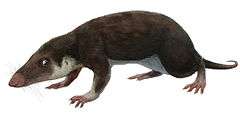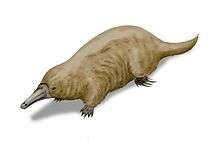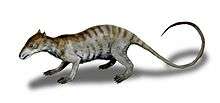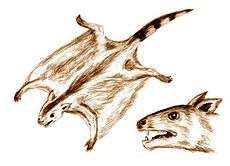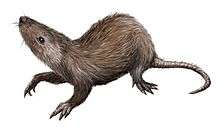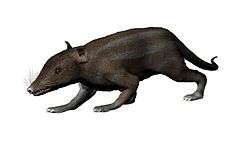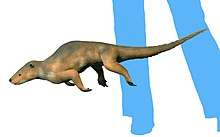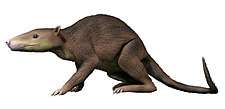Groebertherium
Groebertherium is a genus of dryolestoid mammal from the Late Cretaceous Los Alamitos and Allen Formations of Argentina. It is not closely related to other contemporary dryolestoids, all of which are part of the clade Meridiolestida.[1][2]
| Groebertherium | |
|---|---|
| Scientific classification | |
| Kingdom: | Animalia |
| Phylum: | Chordata |
| Class: | Mammalia |
| Clade: | Cladotheria |
| Superorder: | †Dryolestoidea |
| Order: | †Dryolestida |
| Genus: | †Groebertherium Bonaparte 1986 |
| Type species | |
| Groebertherium stipanicici Bonaparte 1986 | |
Classification
Groebertherium has been consistently recovered as a dryolestoid within Dryolestida and outside of Meridiolestida, though its exact positioning varies among several studies. Rougier et al. 2011, for example, recovers it as a member of Dryolestidae, rendering it a relictual survivor of this clade with a gap of 40 million years in relation to the youngest northern dryolestids,[2] while Harper et al. 2018 recovers it as slightly closer to Meridiolestida than to northern dryolestoids.[1]
Palaeobiology
Unlike meridiolestidans, it retains a parastylar hook on its molariform teeth. Therefore, it was likely less specialised to transverse (side-to-side) mastication.[1][2] It was rather similar to Dryolestes, indicating a similar tenrec or hedgehog-like lifestyle.[2]
References
- Harper, Tony; Parras, Ana; Rougier, Guillermo W. (2018). "Reigitherium (Meridiolestida, Mesungulatoidea) an Enigmatic Late Cretaceous Mammal from Patagonia, Argentina: Morphology, Affinities, and Dental Evolution". Journal of Mammalian Evolution. 26 (4): 447–478. doi:10.1007/s10914-018-9437-x.
- Rougier, Guillermo W.; Apesteguía, Sebastián; Gaetano, Leandro C. (2011). "Highly specialized mammalian skulls from the Late Cretaceous of South America". Nature. 479 (7371): 98–102. Bibcode:2011Natur.479...98R. doi:10.1038/nature10591. PMID 22051679.
